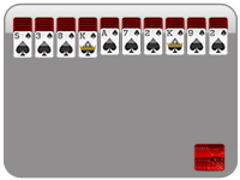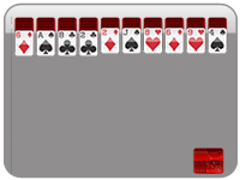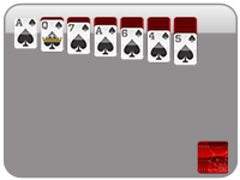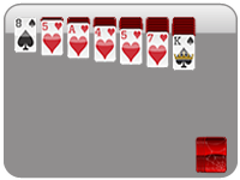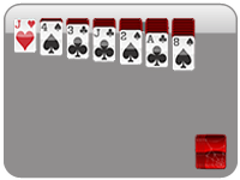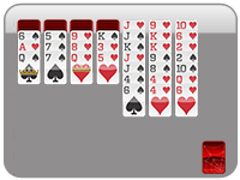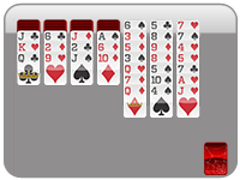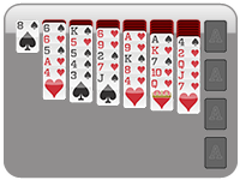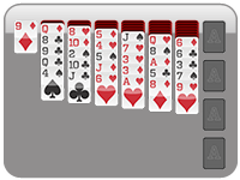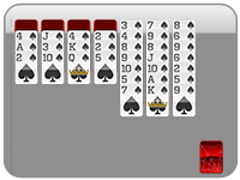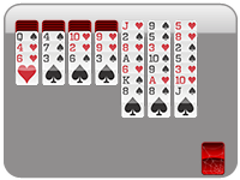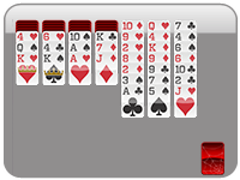Classic Solitaire vs Spider Solitaire: What’s The Difference?
Solitaire is one of the most popular card games. It is one of the few card games that you can play solo, although it can also be played with other players. Its objective involves sorting cards into a systematic order - and it has influenced many puzzles and video games since (from online solitaire to ball sorting mobile games).
What many people don’t realize about solitaire is that it has many different variants. These each have their own rules and objectives. Two of the most notable examples are classic solitaire and spider solitaire.
What are the biggest differences between the two variants? This guide takes a deep dive into both card games and compares them to help you understand them both.
When was classic solitaire invented?
Solitaire is believed to have its origins in the late 1700s. There are beliefs that it may have been inspired by tarot card readings, while other stories suggest that it was invented by lonely prisoners as a way to pass the time. The earliest evidence of such a game comes from a book of game rules published in 1788, which includes a chapter on a game titled ‘patience’ (which solitaire is still sometimes referred to).
Classic solitaire as we know it today is often also referred to as ‘klondike’. This game likely got its name from the late 1800s Klondike gold rush. The earliest printed rules for klondike can be found in a 1907 book. It was likely played heavily before this, but known by different names. Throughout the 20th century, classic solitaire (i.e. klondike) would become increasingly popular.
When was spider solitaire invented?
Spider Solitaire was not invented until a little later. It is unclear who invented this variant, however its first mention can be found in a book from 1917. A book published in 1949 would later include the version that most of us know today, including a guide to playing a sub-variant called spiderette. Microsoft would later increase the popularity of spider solitaire by including it as a pre-installed game on all Windows computers.
Why is it called ‘spider’ solitaire? Because, just as a spider has eight legs, spider solitaire involves eight foundation piles onto which each full sequence of cards is placed. Many people refer to the game simply as ‘spider’ rather than ‘spider solitaire’.
What are the similarities between classic and spider solitaire?
Both klondike and spider have a few key similarities, which is why they are both classed as solitaire. These similarities are listed below:
- Both classic and spider solitaire can be played alone or with other players.
- Both classic and spider solitaire consist of a stockpile, tableau and foundations.
- In each case, the tableau consists of multiple columns of cards. Most of the cards are dealt face down with a single face-up card on top of each pile.
- You must then arrange the face up cards in a systematic order (either ascending or descending order depending on the game) by stacking them upon one another. Once a face-up card is moved from a column, the face-down card below it is placed face-up.
- If none of the face-up cards can be stacked upon another card, you have an option to draw cards from the stockpile.
- The end goal is to turn all the face-down cards face-up and arrange them all into stacks in ascending/descending order. These complete stacks are placed off the tableau on an area known as the ‘foundations’.
What are the main differences between classic and spider solitaire?
There are some key differences between classic and spider solitaire that are important to understand when distinguishing both games. These differences are detailed below.
Number of decks
Classic solitaire uses a single deck of 52 cards. The deck is shuffled at the beginning and the cards are then dealt onto the tableau.
Spider solitaire meanwhile uses two decks of 52 cards (so a total of 104 cards). These are similarly shuffled and dealt on the tableau.
Tableau layout
A big difference between classic and spider solitaire is the tableau layout.
In classic solitaire (klondike), there are 7 columns of cards. Starting from the left:
- The first column contains a single face-up card.
- The second column contains two cards: a single face-down card with a single face-up card on top.
- The third column contains three cards: two face-down cards with a single face-up card on top.
- The fourth column contains four cards: three face-down cards with a single face-up card on top.
- The fifth column contains five cards: four face-down cards with a single face-up card on top.
- The sixth column contains six cards: five face-down cards with a single face-up card on top.
- The seventh column contains seven cards: six face-down cards with a single face-up card on top.
There should be 28 cards on the tableau. The remaining 24 cards in the deck are placed in the stockpile, which you can draw from if there are no moves left on the tableau.
In spider solitaire, there are 10 columns of cards. Starting from the left:
- Columns 1, 2, 3 and 4 each contain six cards: five face-down cards and a single face-up card on top.
- Columns 5, 6, 7, 8, 9 and 10 each contain five cards: four face-down cards and a single face-up card on top.
There should be 54 cards on the tableau. The remaining 50 cards from the two decks stay in the stockpile, which you can draw from if there are no moves left on the tableau.
It’s worth noting that these are the standard ‘official’ versions of each game, but some people may play each version slightly differently.
Stacking rules
In classic solitaire (klondike), face-up cards can be stacked in one of two ways:
- Cards of the same suit must be stacked in ascending order from ace to king (e.g. 6 ♦, 7 ♦, 8 ♦, 9 ♦).
- Cards of alternative colored suits can be stacked in descending order from king to ace (e.g. J ♥, 10 ♦, 9 ♥, 8 ♦). This rule is not always permitted in some versions.
In spider solitaire, cards do not have to be stacked by suit. However, cards must be stacked in descending order from king to ace. Computer software versions of this game may convert all the cards entirely into one suit to prevent confusion. Klondike suit-stacking rules can be applied to spider if you want to make the game more challenging (often software versions will allow you to play with two or four suits).
Foundation piles
The objective of both klondike and spider is to have all the cards on the tableau arranged in systematic order and placed on the foundation spaces, which are located above the tableau.
In classic solitaire, there are four foundation piles to complete. This could be a pile of every suit in ascending order (ace to king), or four piles of alternate colored suits in descending order (king to ace) depending on which way you decide to play.
In spider solitaire, there are eight foundation piles to complete. Each pile should contain a full sequence of cards in descending order from king to ace. Unless the rules state otherwise, these do not have to be of a single suit.
Drawing cards
If there are no moves left that you can do on the tableau, both classic and spider solitaire give you the option of drawing from the stockpile. However, how you draw and how many cards you draw varies between both games.
In classic solitaire, a single card is drawn and placed in the waste pile. If that card is able to be stacked on any other card on the tableau, you may remove it from the waste pile and play it. If not, it stays in the waste pile.
In spider solitaire, it is more common for ten cards to be drawn at once, which are automatically placed face-up over each column. This draw rule makes spider much more challenging, because you then have to sort all of these face-up cards into the correct sequences.
Is spider solitaire more difficult?
Spider solitaire is often regarded as being much more difficult than classic solitaire (klondike). This is because spider solitaire uses two decks and therefore there are many more cards to get through. A greater percentage of the cards on the tableau are also face-down, even though there are more columns to choose from. The draw rule commonly used in spider solitaire also complicates things further.
One aspect where things are easier is the use of suits. In classic solitaire, you need to make sure that stacks of cards are all the same suit or alternate color suits depending on how you play. In a basic game of spider solitaire, you don’t have to worry about following suit. However, as already mentioned, there are more difficult variants where you can choose to stack cards by suit. When introducing these rules, spider solitaire is undeniably harder than classic solitaire.
It is worth noting that in both classic and spider solitaire, there are games that can be unsolvable, depending on how the cards are shuffled and drawn. About 82 to 91.5% of classic solitaire (klondike) games are solvable. The chances of solvability are less when playing spider solitaire with physical cards. However, digital versions of both classic and spider solitaire are typically able to up the odds. In fact, some games are able to provide a 99% or 100% solvability rate, using algorithms to avoid displaying tableaus that cannot be completed so that there is always a chance to win.
Is spider solitaire less popular?
Classic solitaire is more popular when playing with physical cards. Using a single deck is much more convenient for many people and the tableau is easier to lay out. It also has a longer history and is therefore commonly passed down by families as the way to play solitaire.
That said, spider solitaire is much more popular on a computer. Its popularity is largely down to its inclusion on almost every Microsoft Windows operating system since Windows 98. In fact, before then, the game was almost unheard of. Software-based versions of this game allow for faster play, as well as enabling options such as playing with a single suit. Many online versions of spider solitaire - including websites and apps - have further increased its popularity by introducing new variants. Some of these websites include online variants of klondike too.
Where can I play each version?
If you have a deck of physical cards, you can play classic solitaire using these. Just make sure to take out the jokers and extra cards.
To play spider solitaire with physical cards, you’ll need two decks of cards. It's important that these two decks are identical - you don’t want to use cards that are different sizes or that have different backgrounds. You should similarly take out the jokers and any extra cards before playing.
Both classic solitaire and spider solitaire can be played as software versions. As already mentioned, Spider Solitaire is available as a free game on most Windows PCs. However, you can explore different variants by looking into online games.
247 Spider Solitaire is a great example of this - and it’s free! Try giving it a go today and see what you think.
How do online variants differ?
The most basic version of spider solitaire includes only using 1 suit. But as you’ll find here on 247 Spider Solitaire, there are many different variants that can be worth trying out, some of which borrow certain rules and features from classic solitaire. Some of the different variants to try include:
- Spider (2 suite): This is standard spider, but sequences of cards must follow one of two suits. This provides increased difficulty compared to standard spider.
- Spider (4 suite): Like classic solitaire, this version of spider solitaire requires you to sort cards into all four suits. This increases the difficulty even more so.
- Spiderette: This version is essentially classic solitaire (klondike) but with a single suit. Cards are also placed in descending order like spider. The tableau layout is exactly the same as classic solitaire with seven columns ranging from one card to seven cards.
- Spiderette (2 suit): The same rules as spiderette apply here, but cards must be sorted into one of two suits, helping to increase the difficulty.
- Spiderette (4 suit): This involves all four suits just like classic solitaire. Cards are still stacked in descending order like spider though.
- Wasp: Wasp is a completely different variant of solitaire. It consists of 7 columns of cards - 4 of which contain three face-down cards and four face-up cards, while the remaining three columns are made up of 7 face-up cards. Like spider, the aim is to sort them into descending order using only one suit.
- Wasp (2 suit): This variant uses the same rules as regular wasp, except cards must be sorted into one of two suits.
- Wasp (4 suit): This is wasp solitaire made even more difficult - the same tableau layout applies, but cards must be sorted into four suits in descending order.
- Yukon: Yukon is similar to classic solitaire, but gives you the option of moving entire groups of cards - providing that the top card of this group follows a sequence. This can add a new dynamic to classic solitaire.
- Yukon (4 suit): The same rules as standard yukon apply here, but with four suits in play.
- Scorpion: Scorpion is very similar to wasp, except empty tableau piles can only be filled with a king or a sequence of cards starting with a king (whereas in wasp solitaire, any card can be placed on an empty tableau pile).
- Scorpion (2 suit): This variant uses the same rules as regular scorpion, but you have to arrange cards into two suits.
- Scorpion (4 suit): In this version, cards must be sorted into four suits - increasing the difficulty.
Conclusion
Classic and spider solitaire are both very different games that can each have their own perks. Classic solitaire is the most traditional version and is easier to play with physical cards. Spider solitaire is newer, more challenging and more commonly played as a digital game.
Of course, there are many variants beyond these versions. By testing out all kinds of different types of solitaire, you can add new challenges to the game and find the type of solitaire that you find the most rewarding. Digital games offer the greatest amount of variation and can save you time by automatically dealing out cards, as well as increasing the winnability of each game by minimizing the amounts of unsolvable games.
Spider Solitaire Games
More Solitaire Games
More Games
Spider Solitaire News
Disclaimer
DISCLAIMER: The games on this website are using PLAY (fake) money. No payouts will be awarded, there are no "winnings", as all games represented by 247 Games LLC are free to play. Play strictly for fun.

